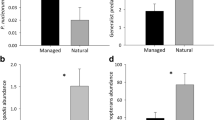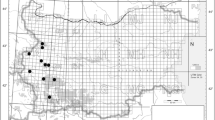Abstract
In tropical forests, ants frequently consume fruit pulp around seeds of vertebrate-dispersed plants, which protects the seeds from infection by fungus and pathogens. Seed cleaning behavior by omnivorous ants was observed in the secondary forests of Bogor botanical garden in West Java. Fruit pulp around the seeds of the rambutan Nephelium lappaceum was completely removed by Pheidole plagiaria, Anoplolepis gracilipes, and other ants. When seed cleaners were excluded, however, many seeds were attacked by fungus and died. Seeds that were cleaned by hand, but not by ants, were similarly attacked. Field experiments on seed cleaning by P. plagiaria revealed that the anti-fungal effect was not merely caused by removal of fruit pulp, and that seed cleaning reduced the development of spores and hypha of fungi. We suggest that the workers apply anti-fungal substances to the fruit pulp and seed surface.




Similar content being viewed by others
References
Akino T, Turushima T, Yamaoka R (1995a) 3 formyl-7, 11-dimethyl-(2E, 6Z, 10)-dodecatrienal: antifungal compound in the mandibular gland of the ant, Lasius fuliginosus Latreille. J Agr Chem Soc Jap 69:1581–1586
Akino T, Turushima T, Yamaoka R (1995b) Antifungal and antibacterial activity of 3-formyl-7, 11-dimethyl-(2E, 6Z, 10)-dodecatrien-1-al in the mandibular gland of Lasius fuliginosus Latreille. Jpn J Appl Entomol Zool 39:329–333
Augspurger CK (1979) Irregular cues and germination and seedling survival of a Panamanian shrub (Hybanthus prunifolius). Oecologia 44:53–59
Augspurger CK (1984) Seedling survival of tropical tree species: interactions of dispersal distance, light-gaps, and pathogens. Ecology 65:1705–1712
Augspurger CK (1990) The potential impact of fungal pathogens on tropical plant reproductive biology. In: Bawa KS, Hadley M (eds) Reproductive ecology of tropical forest plants. Man and the biosphere series, vol. 7. UNESCO, Paris, pp 237–245
Beattie AJ, Turnbull CL, Hough T, Knox RB (1986) Antibiotic production: a possible function for the metapleural glands of ants (Hymenoptera: Formicidae). Ann Ent Soc Am 79:448–450
Beattie AJ, Mackintosh JA, Cruse A, Veal DA (1994) Defense against organisms in the ant Myrmecia gulosa and the termite Nasutitermes exitiosus. In: Lenoir A, Arnold G, Lepage M (eds) Les Insectes Sociaux. 12th Congress of the International Union for the Study of Social Insects IUSSI, Université Paris Nord, pp 108
Byrne MM, Levey DJ (1993) Removal of seeds from frugivore defecations by ants in a Costa Rican rain forest. Vegetatio 107/108:363–374
Currie CR, Scott JA, Summerbell RC, Malloch D (1999a) Fungus-growing ants use antibiotic-producing bacteria to control garden parasites. Nature 398:701–704
Currie CR, Mueller UG, Malloch D (1999b) The agricultural pathology of ant fungus gardens. Proc Natl Acad Sci Am 96:7998–8002
Dix NJ, Webster J (1995) Fungal ecology. Cambridge University Press, Cambridge
Do Nascimento RR, Schoeters E, Morgan ED, Billen J, Stradling DJ (1996) Chemistry of metapleural gland secretions of three attine ants, Atta sexdense rubropilosa, Atta cephalotes, and Acromyrmex octospinosus (Hymenoptera: Formicidae). J Chem Ecol 22:987–1000
Golley FB (1983) Tropical rain forest ecosystem. Ecosystem of the world 14A. Elsevier, Amsterdam
Guimarães PR Jr, Cogni P (2002) Seed cleaning of Cupania vernalis (Sapindaceae) by ants: edge effect in a highland forest in south-east Brazil. J Trop Ecol 18:303–307
Herrera CM, Pellmyr O (2002) Plant-animal interactions, an evolutionary approach, Blackwell, Oxford
Horvitz CC, Beattie AJ (1980) Ant dispersal of Calathea (Marantaceae) seeds by carnivorous ponerines (Formicidae) in a tropical rain forest. Am J Bot 67:321–326
Horvitz CC, Schemske DW (1986) Seed dispersal of a neotropical myrmecochore: variation in removal rates and dispersal distance. Biotropica 18:319–323
Horvitz CC, Schemske DW (1994) Effects of dispersers, gaps, and predators on dormancy and seedling emergence in a tropical herb. Ecology 75:1949–1958
Isaac S, Frankland JC, Watling R, Whalley AJS (1993) Aspects of tropical mycology. Cambridge University Press, Cambridge
Jaffé K, Vasquez C, Brandwijk L, Cabrera A (1994) Metapleural gland secretions in ants. In: Lenoir A, Arnold G, Lepage M (eds) Les Insectes Sociaux. 12th congress of the international union for the study of social insects IUSSI, Université Paris Nord, pp 217
Kaspari M (1993) Removal of seeds from Neotropical frugivore droppings, ant responses to seed number. Oecologia 95:81–88
Kaufman S, Mckey DB, Mckey MH, Horvitz CC (1991) Adaptations for a two-phase seed dispersal system involving vertebrates and ants in a hemiepiphytic fig (Ficus microcappa: Moraceae). Am J Bot 78:971–977
Knapp JJ, Jackson CW, Howse PE, Vilela EF (1994) Mandibular gland secretions of leaf-cutting ants: role in defense against alien fungi. In: Lenoir A, Arnold G, Lepage M (eds) Les Insectes Sociaux. 12th congress of the international union for the study of social insects IUSSI, Université Paris Nord, pp 109
Leal IR, Oliveira PS (1998) Interactions between fungus-growing ants (Attini), fruits and seeds in cerrado vegetation in southeast Brazil. Biotropica 30:170–178
Leal IR, Oliveira PS (2000) Foraging ecology of attine ants in a Neotropical savanna: seasonal use of fungal substrate in the cerrado vegetation of Brazil. Insectes Soc 47:376–382
Levey DJ, Byrne MM (1993) Complex ant-plant interactions: rain forest ants as secondary dispersers and post-dispersal seed predators. Ecology 74:1802–1812
Maschwitz U (1974) Vergleichnde Untersuchungen zur Funktion der Ameisen-metathorakaldrüse. Oecologia 16:303–310
Ohkawara K (2001) Effect of two army ant species, Dorylus laevigatus and Pheidologeton affinis, on seed survival and germination in bird-dispersed plant Dysoxylum alliaceum. Tropics 10:421–426
Oliveira PS, Galetti M, Pedroni F, Morellato LPC (1995) Seed cleaning by Mycocepurus goeldii ants (Attini) facilitates germination in Hymenaea courbaril (Caesalpiniaceae). Biotropica 27:518–522
Passos L, Oliveira PS (2002) Ants affect the distribution and performance of Clusia criuva seedlings, a primarily bird-dispersed rainforest tree. J Ecol 90:517–528
Passos L, Oliveira PS (2003) Interactions between ants, fruits, and seeds in a restinga forest in south-eastern Brazil. J Trop Ecol 19:261–270
Passos L, Oliveira PS (2004) Interaction between ants and fruits of Guapira opposita (Nyctaginaceae) in a Brazilian sandy plain rainforest: ant effects on seeds and seedlings. Oecologia 139:376–382
Pizo MA, Oliveira PS (1998) Interaction between ants and seeds of a nonmyrmecochorous neotropical tree, Cabralea canjerana (Meliaceae), in the Atlantic forest of southeast Brazil. Am J Bot 85:669–674
Pizo MA, Oliveira PS (1999) Removal of seeds from vertebrate feces by ants: effects of seed species and deposition site. Can J Zool 77:1595–1602
Pizo MA, Oliveira PS (2000) The use of fruits and seeds by ants in the Atlantic forest of southeast Brazil. Biotropica 32:851–861
Roberts JT, Heithaus ER (1986) Ants rearrange the vertebrate-generated seed shadow of a neotropical fig tree. Ecology 67:1046–1051
Acknowledgements
We express sincere thanks to Prof. K. Yamauchi and Associate Prof. F. Ito for their useful suggestions and help with the fieldwork. We also thank Dr. P.S. Oliveira and Dr. J.T. Longino for critically reading the manuscript. Cordial thanks are due to Dr. Woro A. Noerdjito, Dr. Sih Kahono, and Erniwati for their help with the research. This study was supported in part by the Japan Ministry of Education, Science, Sports and Culture Grant for Overseas Research (No. 10740417, No 11691130).
Author information
Authors and Affiliations
Corresponding author
About this article
Cite this article
Ohkawara, K., Akino, T. Seed cleaning behavior by tropical ants and its anti-fungal effect. J Ethol 23, 93–98 (2005). https://doi.org/10.1007/s10164-004-0132-4
Received:
Accepted:
Published:
Issue Date:
DOI: https://doi.org/10.1007/s10164-004-0132-4




